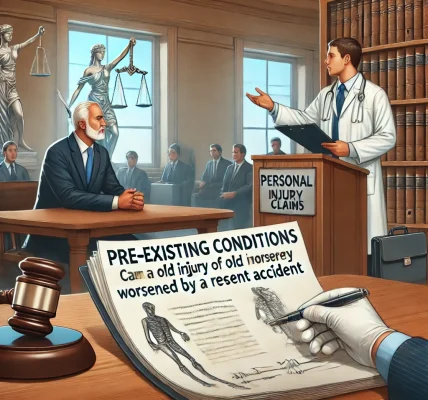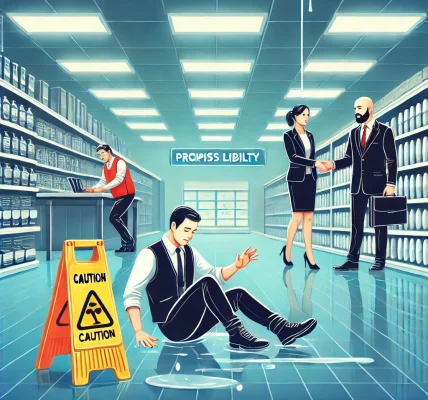Negligence is a fundamental concept in personal injury law, playing a crucial role in determining liability and compensation. If you have suffered an injury due to someone else’s actions or inactions, proving negligence is key to winning your claim. This comprehensive guide will help you understand what negligence is, how it is established, and how it impacts personal injury cases.
What Is Negligence in Personal Injury Law?
Negligence occurs when an individual or entity fails to exercise reasonable care, resulting in harm or injury to another person. Personal injury claims are built on the principle that the responsible party had a duty of care, breached that duty, and caused damage as a result.
Common Examples of Negligence:
- A distracted driver causing a car accident.
- A store failing to clean up a spill, leading to a slip-and-fall injury.
- A doctor making an avoidable medical error.
- A property owner neglecting to fix hazardous conditions on their premises.
Understanding negligence helps victims recognize when they have a valid claim and what steps they need to take to seek compensation.
The Four Key Elements of Negligence
To establish negligence in a personal injury case, you must prove the following four elements:
1. Duty of Care
The defendant (the person or entity you are suing) must have owed a legal duty of care to the injured party.
Examples of Duty of Care:
- Drivers have a duty to follow traffic laws and operate vehicles safely.
- Property owners must maintain safe premises for visitors.
- Doctors have a duty to provide competent medical care.
2. Breach of Duty
The defendant must have failed to uphold their duty of care. This can occur through action or inaction.
Examples of Breach of Duty:
- A driver texting while driving and causing an accident.
- A business owner ignoring a broken stairway.
- A doctor failing to diagnose a treatable illness.
3. Causation
The plaintiff (injured party) must prove that the defendant’s breach of duty directly caused their injury. This is often demonstrated through medical records, expert testimony, and accident reports.
Two Types of Causation:
- Actual Cause (Cause-in-Fact): The injury would not have happened “but for” the defendant’s negligence.
- Proximate Cause: The harm was a foreseeable result of the defendant’s actions.
4. Damages
The plaintiff must have suffered actual harm—physical, financial, or emotional—to pursue compensation.
Types of Damages:
- Economic Damages: Medical bills, lost wages, property damage.
- Non-Economic Damages: Pain and suffering, emotional distress, loss of enjoyment of life.
Without proving damages, even clear negligence may not result in compensation.
Comparative vs. Contributory Negligence
Different states follow different legal doctrines when determining negligence and compensation:
1. Comparative Negligence
If the injured party shares some fault in the accident, their compensation may be reduced proportionally.
Example: If a pedestrian was jaywalking when hit by a speeding driver, the pedestrian may be found 20% at fault. If the total damages are $100,000, they would receive $80,000 after a 20% reduction.
Types of comparative negligence systems:
- Pure Comparative Negligence: The plaintiff can recover damages even if they are 99% at fault, though the amount is reduced based on their percentage of fault.
- Modified Comparative Negligence: The plaintiff can recover damages only if they are less than 50% or 51% responsible.
2. Contributory Negligence
In some states, if the injured party is found to be even 1% at fault, they cannot recover any compensation. This rule is harsh and applies in only a few states.
How to Prove Negligence in a Personal Injury Case
Proving negligence requires solid evidence to demonstrate fault and damages. Here’s what can help strengthen your claim:
1. Gather Evidence at the Scene
- Take photos and videos of the accident location, injuries, and property damage.
- Obtain witness contact information and statements.
- Preserve any physical evidence, such as damaged clothing or equipment.
2. Obtain Official Reports
- File a police report for car accidents and request a copy.
- Report workplace injuries to supervisors and document their response.
- Request medical records to link injuries to the accident.
3. Keep Medical and Financial Records
- Maintain records of all medical treatments and expenses.
- Document lost wages and other financial impacts.
- Keep a journal detailing pain, suffering, and the impact on daily life.
4. Work with Experts
- Accident reconstruction experts can help prove how the incident occurred.
- Medical professionals can testify about the severity of injuries.
- Economists can estimate long-term financial losses.
Defenses Against Negligence Claims
Defendants may use various legal defenses to reduce or deny liability, such as:
1. Assumption of Risk
The plaintiff knowingly engaged in a risky activity (e.g., signing a waiver before skydiving).
2. No Duty of Care
The defendant may argue that they had no legal obligation to protect the plaintiff.
3. Third-Party Liability
The defendant may claim another party was responsible, such as a manufacturer in product liability cases.
4. Pre-Existing Conditions
The defense may argue that the plaintiff’s injuries were not caused by the accident but were due to a pre-existing medical condition.
Conclusion: Protecting Your Rights in a Negligence Claim
Understanding negligence is crucial for anyone involved in a personal injury case. By proving duty of care, breach, causation, and damages, you can build a strong claim for compensation. However, navigating the legal process can be complex, especially when dealing with comparative or contributory negligence laws.
If you have been injured due to someone else’s negligence, consulting an experienced personal injury lawyer can significantly improve your chances of receiving fair compensation. Legal professionals can gather evidence, negotiate with insurance companies, and represent your best interests in court.
Key Takeaway: Being informed about negligence laws empowers you to make smart decisions and take the right steps toward justice. If you believe you have a case, act promptly and seek legal guidance to protect your rights and maximize your compensation.




